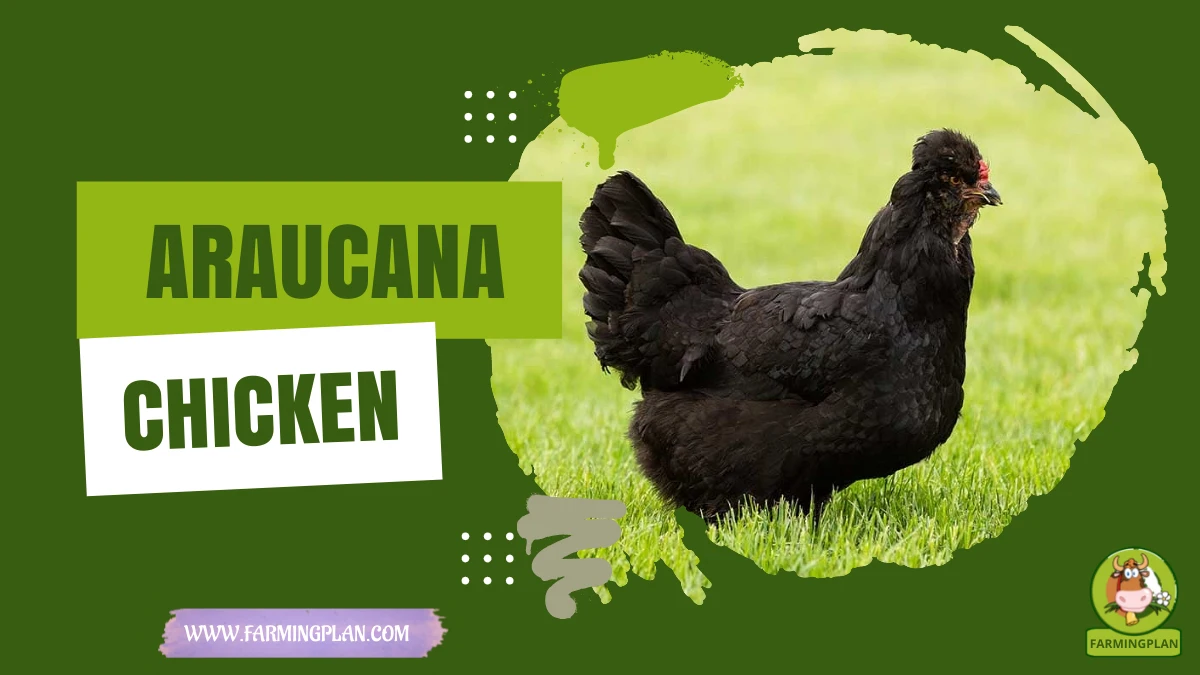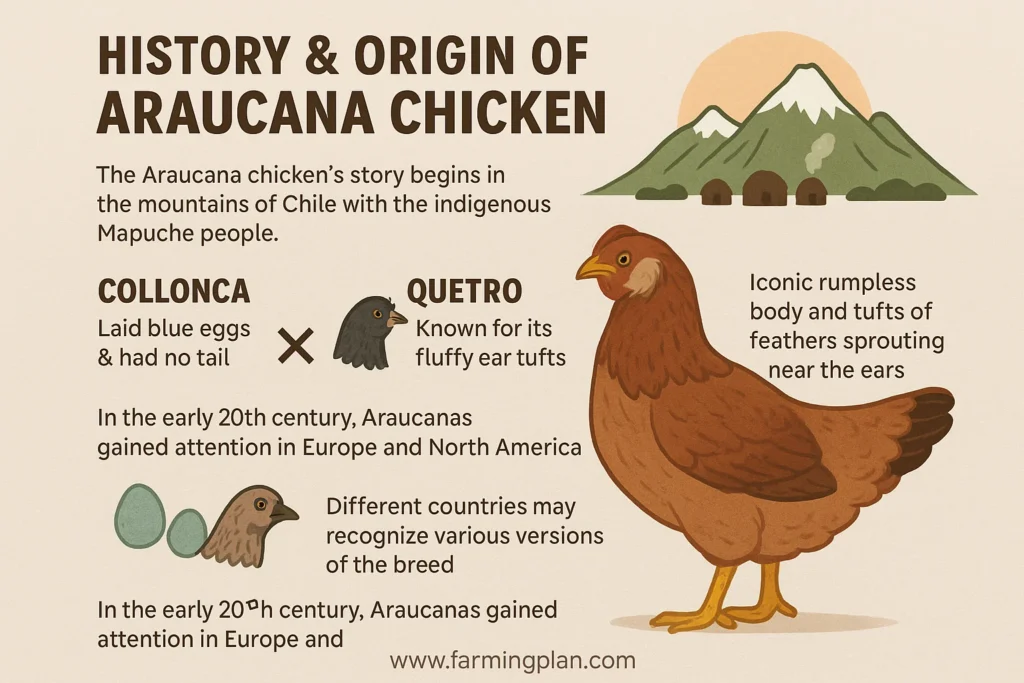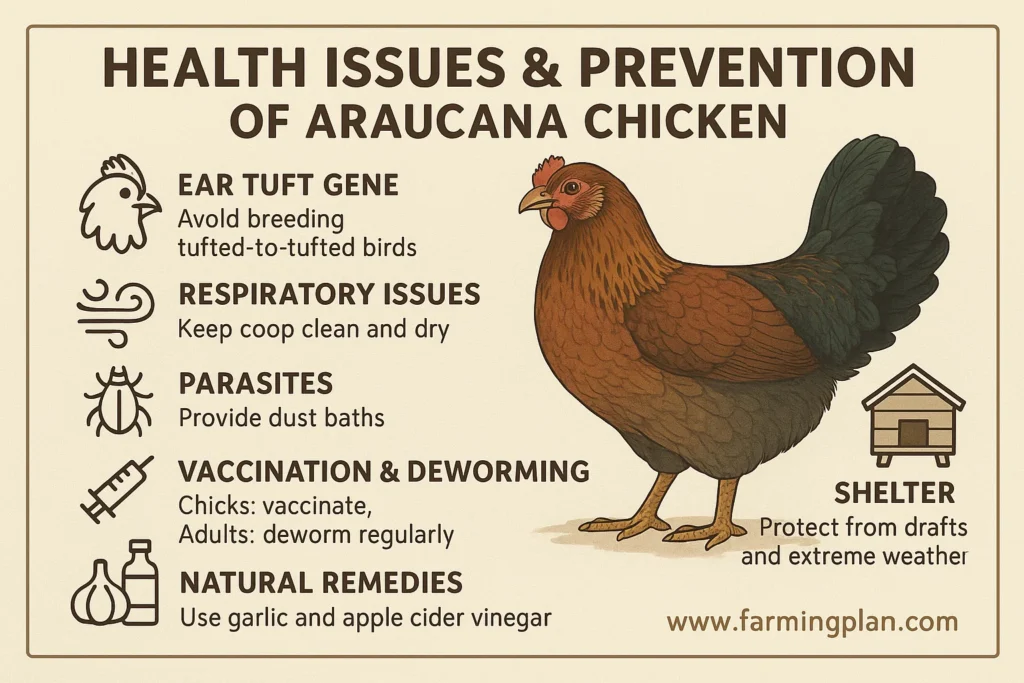If you’ve ever dreamed of collecting blue eggs from your backyard coop, the Araucana chicken is your dream come true. This unique breed, known for its vivid egg color and charming appearance, hails from South America and brings a splash of excitement to any flock. In this guide, I’ll share everything I’ve learned from raising Araucanas myself—from their quirky traits and rumpless backs to their ear tufts and gentle personalities. Whether you’re a backyard chicken enthusiast, hobby breeder, or small-scale farmer, you’ll find all the essential info you need to raise happy, healthy Araucanas right here.

History & Origin of Araucana Chicken
The Araucana chicken’s story begins in the mountains of Chile with the indigenous Mapuche people. These chickens are the result of crossing two ancient breeds—the Collonca, which laid blue eggs and had no tail, and the Quetro, known for its fluffy ear tufts. The combination produced a chicken with both traits: the iconic rumpless body and tufts of feathers sprouting near the ears.

In the early 20th century, Araucanas gained attention in Europe and North America, where breeders were captivated by their novelty. Despite their exotic charm, these chickens are not just ornamental. They were (and still are) valued for their egg production and adaptability. Today, while the American Poultry Association has strict standards for what qualifies as a true Araucana, different countries may recognize various versions of the breed.
Read More: San Juan Rabbit: Hardy Survivor With a Wild Past
Characteristics of Araucana Chicken
Araucanas are instantly recognizable, boasting a unique set of traits that make them stand out in any coop. Their lack of a tail, making them rumpless, gives them a sleek profile that sets them apart from nearly every other breed. Coupled with their fluffy ear tufts, a result of a dominant but tricky gene, these birds look like they’ve stepped out of a fantasy novel.
They have pea combs, a practical and distinctive trait that helps them tolerate cold weather, and they come in various color patterns like black, white, blue, splash, and wheaten. Bantam versions are also available for those with smaller coops. Another thing? These birds aren’t just about looks. They lay medium-sized, pale blue eggs, which come from the rare ocean gene that causes the blue pigment to be deposited throughout the shell—not just on the surface like green eggs.
But be cautious if you’re breeding them. The ear tuft gene can be lethal when inherited from both parents, often resulting in unhatched chicks. Responsible breeders carefully plan pairings to reduce the risks while keeping this quirky trait alive.
Nature & Temperament of Araucana Chicken
One of the many things I love about Araucanas is their temperament. They’re curious, active, and a bit mischievous—in a fun way. These birds like to forage and explore, making them extraordinary free-range chickens. They’re not overly loud or aggressive, which means they get along well in mixed flocks, especially when introduced gradually.
Araucanas are people-friendly and often become favorites among kids for their calm demeanor and silly looks. Roosters can be protective, but in my experience, they’re not overly aggressive unless provoked. This makes the breed a fantastic choice for families or new chicken keepers looking for a laid-back companion with a twist.
Food & Diet of Araucana Chicken
Feeding Araucanas is straightforward. I stick to a quality layer feed with about 16-18% protein for my hens. During molting or in cold months, I bump that up with some extra protein—mealworms, scrambled eggs, or high-protein feed. Always provide clean, fresh water and grit to aid digestion, especially if they’re free-ranging.

They also enjoy kitchen scraps like greens, fruits (avoid citrus), and cooked veggies, but don’t overdo it. Avoid giving them salty, moldy, or processed foods. Calcium (in the form of crushed oyster shells) is crucial for strong eggshells, especially since blue eggs can sometimes be more brittle than brown ones.
Read More: Beautiful Cubalaya Chicken: A Remarkable Heritage Breed
Usage & Purpose of Araucana Chicken
Araucanas are primarily known for their eggs. Those blue beauties are not only eye-catching but also nutritious. They’re medium-sized and laid consistently through most of the year, even in winter if you provide proper lighting. The blue color of their eggs is due to a rare gene called the ‘ocean gene’, which deposits the blue pigment throughout the shell, not just on the surface like green eggs.
Aside from egg-laying, Araucanas are used in breeding programs, especially by those wanting to create designer chickens like Easter Eggers or Olive Eggers. Their distinct genes make them valuable in genetic studies and crossbreeding experiments. While not typically raised for meat due to their smaller size and rumpless structure, they still provide decent carcass weight if needed.
“Blue Eggs, Bold Looks—The Araucana Is Pure Poultry Magic!”
Special Features Araucana Chicken
Araucanas have some rare traits that make them stand out in any coop:
- Blue Egg Gene (Oocyan): This gene makes their eggs blue all the way through the shell.
- Rumpless Body: Lacking a tail gives them a sleek, almost hawk-like profile.
- Ear Tufts: Unique feather tufts near the ears, though this trait is genetically tricky.
- Pea Comb: A cold-hardy trait that’s practical and distinctive.
- Color Variety: They come in shades like splash, blue, black, and white.
Health Issues & Prevention of Araucana Chicken
Araucanas are generally hardy, but they do have some health quirks. The ear tuft gene can lead to chick mortality, so avoid breeding tufted-to-tufted birds. They’re also prone to respiratory issues if kept in damp, poorly ventilated coops.

Make sure their coop stays clean and dry, and offer dust baths to help them manage mites or lice. Vaccinating chicks and deworming adults regularly also go a long way. I use natural remedies like garlic and apple cider vinegar in their water weekly to boost immunity. Keep a close eye on them during extreme weather; although they tolerate cold well thanks to their pea comb, they still need shelter from drafts.
Step-by-Step Pet Owner & Farming Guide: Raising Araucanas From Chick To Hen
Step 1: Set Up a Safe Coop
Start with a secure, well-ventilated coop. Since Araucanas can be flighty and curious, make sure your fencing is tall and predator-proof. I recommend 4 square feet per bird inside the coop and at least 10 square feet in the run. Include nesting boxes and perch space.
Step 2: Choose Quality Chicks or Hatching Eggs
Get chicks from a reputable breeder, especially if you want true Araucanas. Many hatcheries sell lookalikes (like Easter Eggers), so check for ear tufts, pea combs, and rumpless backs. If you’re hatching eggs, use an incubator with good humidity control.
Step 3: Feed For Growth and Health
From day one, give chicks starter feed with 20-22% protein. Transition to grower feed at 8 weeks, then to layer feed around 18-20 weeks. Supplement with greens and grit. Keep fresh water available at all times and use a chick-safe waterer.
Step 4: Monitor Behavior & Development
Watch for any signs of illness—fluffed-up feathers, droopy wings, or off behavior. Araucanas should be active and alert. As they grow, you’ll notice unique traits like ear tufts and body shape developing.
Step 5: Integrate Into Flock Carefully
Araucanas are peaceful but do best when introduced to new flocks slowly. Use a see-through divider for a few days before full integration. Keep an eye on pecking order issues.
Expert Tips & Best Practices: Raise Araucanas Like A Pro
- Never breed two tufted birds. The double tuft gene is lethal.
- Clean the coop weekly. These birds are sensitive to dampness.
- Provide calcium daily. It strengthens those blue eggs.
- Let them forage. Araucanas love bugs and weeds.
- Label chicks early. Some hatch without tufts or tails but are still pure.
FAQs
Do Araucana chickens lay blue eggs?
Yes, they’re famous for it! Their eggs are blue due to the oocyan gene, which colors the shell all the way through.
Are Araucanas good for beginners?
Absolutely! They’re friendly, curious, and fairly low-maintenance if you manage their coop well.
What’s the difference between Araucana and Easter Egger?
Easter Eggers are hybrids and may not have consistent traits. True Araucanas have blue eggs, tufts, and are rumpless.
Can Araucanas be raised in cold climates?
Yes. Their pea comb helps prevent frostbite, and they do well with proper shelter.
How long do Araucanas live?
With good care, they can live 7 to 10 years, sometimes longer.
Conclusion
Raising Araucana chickens is an incredibly rewarding experience. Their blue eggs, quirky appearance, and friendly nature make them a standout addition to any backyard flock. They’re hardy birds, adaptable to various climates, and offer both beauty and productivity. Whether you’re in it for the unique genetics, the stunning egg basket, or want a friendly bird that’ll brighten your mornings, the Araucana delivers. Try adding a few to your coop—you won’t regret it!

